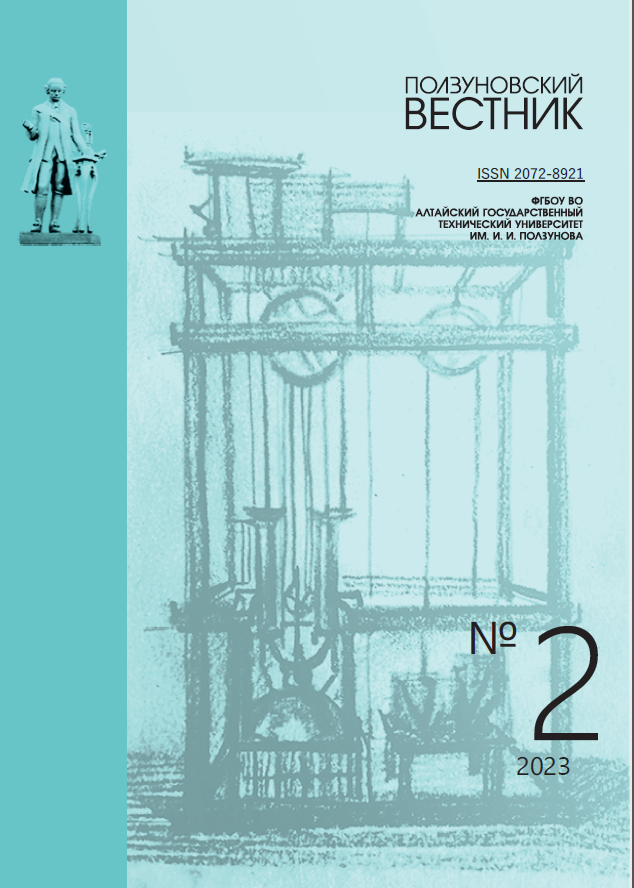INVESTIGATION OF THE POSSIBILITY OF USING HYDROLYZED COLLAGEN IN PROCESSED CHEESE TECHNOLOGY
EVBUBT
DOI:
https://doi.org/10.25712/ASTU.2072-8921.2023.02.014Keywords:
processed cheese, hydrolyzed collagen, rheology, structural and mechanical characteristics.Abstract
Hydrolyzed collagen has proven itself well in the food industry in terms of improving the structural and mechanical properties of products (soups, beverages, meat and dairy products). In the dairy industry, collagen is mainly used in the formulation of beverages, information about the use of hydrolyzed collagen in the formulation of processed cheeses has not been found.
The relationship between the introduction of hydrolyzed collagen into the formulation of processed cheese and changes in its structural and mechanical properties has been studied.
It was found that the sample of cheese with collagen has significantly more viscous and adhesive properties compared to the control sample. The absence of peaks of tensile strength throughout the experiment was revealed when immersed at a speed of 10 mm/s in samples of processed cheese of a straight horizontal indenter to a depth of 50 mm. The increase in effort on the indenter goes smoothly enough. The resistance to immersion of the indenter in the samples under study varies with the progress depending on the degree of structure formation in the cheeses. Organoleptic studies of cheese samples confirmed these patterns.
The introduction of hydrolyzed collagen into the formulation improves the structural and mechanical properties of processed cheeses. Hydrolyzed collagen is recommended for use in the formulation of processed pasty cheeses.
References
León-López A., Morales-Peñaloza A., Mar-tínez-Juárez V.M., Vargas-Torres A., Zeugolis D.I., Aguirre-Álvarez G. Hydrolyzed Collagen – Sourcesand Applications // Molecules. 2019. 24(22):4031. https://doi.org/10.3390/molecules24224031.
Gulevsky A.K., Shcheniavsky I.I. Collagen: structure, metabolism, production and industrial ap-plication // Biotechnol. Acta. 2020. Vol. 13. № 5. P. 42–61. https://doi.org/10.15407/biotech13.05.042.
Костылева Е.В., Середа А.С., Великорецкая И.А., Курбатова Е.И., Цурикова Н.В. Использование протеолитических ферментов для получения белковых гидролизатов пищевого назначения из вторичного сырья // Вопросы питания. 2023. Т. 92. № 1. С. 116–132. https://doi.org/10.33029/0042-8833-2023-92-1-116-132.
Gelse K., Pöschl E., Aigner T. Collagens –structure, function, and biosynthesis // Advanced drug delivery reviews. 2003. Т. 55. № 12. С. 1531–1546. https://doi.org/10.1016/j.addr.2003.08.002.
Hays N.P. [et al]. Effects of whey and fortified collagen hydrolysate protein supplements on nitro-gen balance and body composition in older women // Journal of the American dietetic association. 2009. Т. 109. № 6. С. 1082–1087. https://doi.org/10.1016/ j.jada.2009.03.003.
Zorrilla García A.E. El envejecimiento y el es-trésoxidativo // Revistacubana de investigaciones-Biomédicas. 2002. Т. 21. № 3. С. 178–185.
Varani J. [et al]. Decreased collagen produc-tion in chronologically aged skin: roles of age-dependent alteration in fibroblast function and defec-tive mechanical stimulation // The American journal of pathology. 2006. Т. 168. № 6. С. 1861‒1868. https://doi.org/10.2353/ajpath.2006.051302.
Baumann L. Skin ageing and its treatment // The Journal of Pathology: A Journal of the Patholog-ical Society of Great Britain and Ireland. 2007. Т. 211. № 2. С. 241‒251. https://doi.org/10.1002/path.2098.
Vidal A.R., Ferreira T.E., Mello R.D.O., Schmidt M.M., Kubota E.H., Demiate I.M. [et al]. Ef-fects of enzymatic hydrolysis (Flavourzyme) assisted by ultrasound in the structural and functional proper-ties of hydrolyzates from different bovine collagens // Food Sci. Technol. 2018. Vol. 38, suppl. 1. P. 103‒108. https://doi.org/10.1590/fst.16717.
Pakbin B., Allahyari S., Dibazar S.P., Brück W.M., Vahidi R., Mahmoudi R. [et al]. Produc-tion of bovine collagen hydrolysate with antioxidant activity; optimized by response surface methodology // Sci. Pharm. 2022. Vol. 90. № 4. Р. 62. https://doi.org/10.3390/scipharm90040062.
Qi L., Zhang H., Guo Y., Zhang C., Xu Y. A novel calcium-binding peptide from bovine bone collagen hydrolysate and chelation mechanism and calcium absorption activity of peptide-calcium che-late // Food Chem. 2023. Vol. 410. Article ID 135387. https://doi.org/10.1016/j.foodchem.2023.135387.
Hu G., Wang D., Sun L., Su R., Corazzin M., Sun X. [et al]. Isolation, purification and structure identification of a calcium-binding peptide from sheep bone protein hydrolysate // Foods. 2022. Vol. 11. № 17. Р. 2655. https://doi.org/10.3390/ foods11172655.
Dybka K., Walczak P. Collagen hydroly-sates as a new diet supplement // Biotechnol. Food Sci. 2009. Vol. 73. P. 83–92.
Holwerda A.M., van Loon L.J.C. The impact of collagen protein ingestion on musculoskeletal connective tissue remodeling: a narrative review // Nutr. Rev. 2022. Vol. 80. № 6. P. 1497–1514. https://doi.org/10.1093/nutrit/nuab083.
Pal G.K., Suresh P.V. Sustainable valorisa-tion of seafood by-products: Recovery of collagen and development of collagen-based novel functional food ingredients // Innovative food science & emerg-ing technologies. 2016. Т. 37. С. 201–215. https://doi.org/10.1016/j.ifset.2016.03.015.
Znamirowska A., Szajnar K., Pawlos M. Probiotic Fermented Milk with Collagen // Dairy. 2020. № 1. С. 126–134. https://doi.org/10.3390/dairy1020008.
León-López A., Pérez-Marroquín X.A., Campos-Lozada G., Campos-Montiel R.G., Aguirre-Álvarez G. Characterization of Whey-Based Fer-mented Beverages Supplemented with Hydrolyzed Collagen: Antioxidant Activity and Bioavailability // Foods. 2020. Т. 12. № 9(8):1106. https://doi.org/ 10.3390/foods9081106.
Walrand S., Chiotelli E., Noirt F., Mwewa S., Lassel T. Consumption of a functional fermented milk containing collagen hydrolysate improves the concentration of collagen-specific amino acids in plasma // J Agric Food Chem. 2008. № 56(17):7790-5. https://doi.org/10.1021/jf800691f.
Майоров А.А., Мусина О.Н. Новая серия лабораторного оборудования – новые возможности для фундаментальных и прикладных исследований // Сыроделие и маслоделие. 2016. № 4. С. 22–25.
Майоров А.А., Сиденко Ю.А., Мусина О.Н. Новые наукоемкие приемы оценки реологических свойств в сыроделии: изучение процессов свертывания молока и формирования структуры сгустка // Техника и технология пищевых производств. 2017. № 2 (45). С. 55–61.
Майоров А.А., Сиденко Ю.А. Исследование динамики сычужного свёртывания при формировании структуры молочного сгустка // Мате-риалы II межрегиональной научно-практической конференции с международным участием «От биопродуктов к биоэкономике» (12–13 апреля 2018 г.). Барнаул : Изд-во АлтГТУ, 2018. С. 154–157
Downloads
Published
How to Cite
Issue
Section
License
Copyright (c) 2023 Olga N. Musina, Elena M. Nagornyh

This work is licensed under a Creative Commons Attribution 4.0 International License.















 .
. This work is licensed under a
This work is licensed under a 
